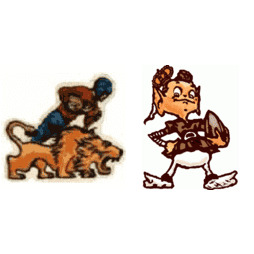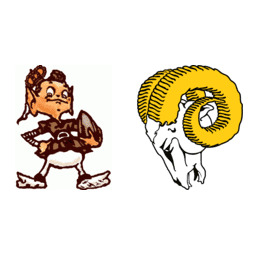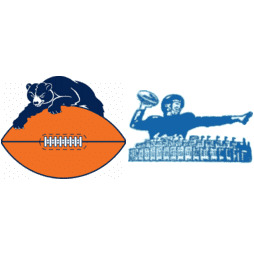SWC75
Bored Historian
- Joined
- Aug 26, 2011
- Messages
- 32,580
- Like
- 62,802
Before we had the Super Bowl, we had the NFL championship game. Super Bowls used to be famous for their blow-outs. Since the mid-nineties they’ve been mostly close games, just like you’d want them to be but most of the games before that were snoozers with one team seemingly doing everything right and the other doing everything wrong. But that happened with the NFL championship game sometimes, too, most famously in 1940, when the Chicago Bears ‘upset’ the Washington Redskins 73-0 in the nation’s capital, still the most points scored in any NFL game and the largest margin of victory.
But things really got bad in the mid-1950’s with consecutive title games of 56-10, 38-14, 47-7 and 59-14. One of those games is not like the others, despite the final scores. Here are the box scores:

 www.pro-football-reference.com
www.pro-football-reference.com

 www.pro-football-reference.com
www.pro-football-reference.com

 www.pro-football-reference.com
Championship - Cleveland Browns at Detroit Lions - December 29th, 1957 | Pro-Football-Reference.com
www.pro-football-reference.com
Championship - Cleveland Browns at Detroit Lions - December 29th, 1957 | Pro-Football-Reference.com
Some observations:
- NFL blow-outs are normally keyed by turnovers. The rosters at that level are too talented to haver many college football type blow-outs where one team has 500 yards and the other team has 200 yards. In 1954 the Lions gifted the Browns with 9 turnovers. The next year the Browns had 8 takeovers vs. the Rams. The Lions got their revenge on the Browns in ’57 when Cleveland coughed up the ball 7 times. But the turnovers in the 1956 game were 3 for the Bears and 2 for the Giants. That didn’t make it 47-7.
- The 1954 Browns were actually out-gained by the Lions, 303-331. The Browns gained more years in ’57, (313), in losing by 45 points than they did in 1954 winning by 46.
- The Lions in 1957 were the only team to have a really strong offensive game with 438 yards. They passed for 396 of those yards. The only team to rush for 200 yards was the browns team the Lions beat that day with 218.
- First downs weren’t very meaningful in these games. The winners had 72 of them, the losers 69. Incremental gains didn’t make these games what they were.
- Three of these games were blow-outs by halftime: 35-10 in ’54, 34-7 in ’56 and 31-7 in ’57. The 1955 game was 17-7 but the Browns scored two more TDs in the third and another in the fourth, pushing it to 38-7 before the Rams got a late touchdown. The losing teams scored 31 points in the first halves and just 14 in the second. It’s hard to keep going when you are swimming upstream.
The 1956 game fascinates me. The Giants had one less turnover than the Bears and outgained them by 78 yards. How did they win by 40 points? They didn’t have long scoring plays: their five offensive touchdowns came on plays totaling 44 yards, with the longest being from 17 yards out. They didn’t get a score directly from a turnover but they did score on a blocked punt. The Giants out-rushed the Bears 126-67 but the passing was close, 222-203. The thing is, the Bears had to put the ball in the air 47 times, (because they were behind so much) while the Giants only passed it 10 times. The Bears had 27 incompletions, 2 interceptions and lost 34 yards in sacks. The Giants had 9, 0 and 6. That made it hard for the Bears to sustain drives, yet they had 19 first downs to the Giants’ 16.
My theory is that, besides yards and turnovers, there’s a third major factor that can impact games that doesn’t appear in the box score. In baseball they talk about ‘bunching your hits’. A good pitcher will “scatter the hits”. My Mets have been credited with “keeping the train moving”. It’s about having your good plays come in a close enough sequence that one builds on another to produce success, even if individual plays aren’t that spectacular. The Giants may have used their 348 yards to manufacture scoring drives while the Bears scattered their 270 yards through many drives where they got a first down or two but them stalled.
I have no ‘play-by-play’ for these games but a highlight film exists on You-Tube:
The action begins at the 5:20 mark.
- The Giants open with a long kick-off return to the Chicago 38. A pass to the 19 and a 17 yard TD run makes it 7-0.
- The Bears return only got to their 15 and the subsequently fumble. The Giants can’t move it but get a field goal. 10-0.
- After another short return to the 18, a log pass gets intercepted and returned to Chicago’s 36. Again, the Giants have to settle for a field goal. 13-0.
- The Bears return the kickoff to the 35 and get a couple of first downs but don’t make it on a 4th and 1. The Giants put on a scoring drive, highlighted by a soft flip from Charlie Conerly to Alex Webster, who runs it down near the goal line, followed by a Alex’s plunge for the score. 20-0.
- The Giants force a punt but muff the return and the bears take advent age by driving for their only score. 20-7.
- A bad whiff of a tackle allows Webster to take a swing pass down the sidelines to set up another Giant touchdown. 27-7.
- A squib kick bounces down toward the goal line and the returner can’t corral it on his first attempted then the Bears are stuck in front of their goal line. They almost have a safety on a sack but the Bear’s punt from the end zone is blocked and recovered in the end zone by the Giants to make it 34-7 at the half.
- The Giants take the second half kickoff down the field to score thanks to 67 yard pass and run by Frank Gifford. 40-7.
- After the, the Bears filled the air with footballs while the Giants started to work their reserves into thew game. They get a late TD on two passes from Conerly to Gifford. 47-7.
- The Bears pass their way down the field to answer the late Giants score but George Blanda gets picked off. The Giants move the ball a bit on a pass from Bobby Clatterbuck to Don Chandler, who is normally their kicker, but Clatterbuck gets sacked and the game ends.
A factor I forgot which also doesn’t show up in the main box score is returns. The Giants had 83 yards on 2 kickoff returns, 46 more on 5 punt returns and 42 on 2 interception returns for a total of 171 return yards. The Bears had 143 yards on 9 kickoff returns but only a single yard on their only punt return and nothing on their only interception. The total isn’t that much of an advantage: 171-144 but you want your return yardage to come on punts and interceptions, not kickoffs. Then there was the blocked punt in the end zone and the fact that two of the turnovers set up score, although they were field goals, not touchdowns.
The Giants won by 40 points not only because they bunched their yards. They did it because they bunched their breaks.
But things really got bad in the mid-1950’s with consecutive title games of 56-10, 38-14, 47-7 and 59-14. One of those games is not like the others, despite the final scores. Here are the box scores:

Championship - Detroit Lions at Cleveland Browns - December 26th, 1954 | Pro-Football-Reference.com
Detroit Lions 10 at Cleveland Browns 56 on December 26th, 1954 - Full team and player stats and box score

Championship - Cleveland Browns at Los Angeles Rams - December 26th, 1955 | Pro-Football-Reference.com
Cleveland Browns 38 at Los Angeles Rams 14 on December 26th, 1955 - Full team and player stats and box score

Championship - Chicago Bears at New York Giants - December 30th, 1956 | Pro-Football-Reference.com
Chicago Bears 7 at New York Giants 47 on December 30th, 1956 - Full team and player stats and box score
Some observations:
- NFL blow-outs are normally keyed by turnovers. The rosters at that level are too talented to haver many college football type blow-outs where one team has 500 yards and the other team has 200 yards. In 1954 the Lions gifted the Browns with 9 turnovers. The next year the Browns had 8 takeovers vs. the Rams. The Lions got their revenge on the Browns in ’57 when Cleveland coughed up the ball 7 times. But the turnovers in the 1956 game were 3 for the Bears and 2 for the Giants. That didn’t make it 47-7.
- The 1954 Browns were actually out-gained by the Lions, 303-331. The Browns gained more years in ’57, (313), in losing by 45 points than they did in 1954 winning by 46.
- The Lions in 1957 were the only team to have a really strong offensive game with 438 yards. They passed for 396 of those yards. The only team to rush for 200 yards was the browns team the Lions beat that day with 218.
- First downs weren’t very meaningful in these games. The winners had 72 of them, the losers 69. Incremental gains didn’t make these games what they were.
- Three of these games were blow-outs by halftime: 35-10 in ’54, 34-7 in ’56 and 31-7 in ’57. The 1955 game was 17-7 but the Browns scored two more TDs in the third and another in the fourth, pushing it to 38-7 before the Rams got a late touchdown. The losing teams scored 31 points in the first halves and just 14 in the second. It’s hard to keep going when you are swimming upstream.
The 1956 game fascinates me. The Giants had one less turnover than the Bears and outgained them by 78 yards. How did they win by 40 points? They didn’t have long scoring plays: their five offensive touchdowns came on plays totaling 44 yards, with the longest being from 17 yards out. They didn’t get a score directly from a turnover but they did score on a blocked punt. The Giants out-rushed the Bears 126-67 but the passing was close, 222-203. The thing is, the Bears had to put the ball in the air 47 times, (because they were behind so much) while the Giants only passed it 10 times. The Bears had 27 incompletions, 2 interceptions and lost 34 yards in sacks. The Giants had 9, 0 and 6. That made it hard for the Bears to sustain drives, yet they had 19 first downs to the Giants’ 16.
My theory is that, besides yards and turnovers, there’s a third major factor that can impact games that doesn’t appear in the box score. In baseball they talk about ‘bunching your hits’. A good pitcher will “scatter the hits”. My Mets have been credited with “keeping the train moving”. It’s about having your good plays come in a close enough sequence that one builds on another to produce success, even if individual plays aren’t that spectacular. The Giants may have used their 348 yards to manufacture scoring drives while the Bears scattered their 270 yards through many drives where they got a first down or two but them stalled.
I have no ‘play-by-play’ for these games but a highlight film exists on You-Tube:
The action begins at the 5:20 mark.
- The Giants open with a long kick-off return to the Chicago 38. A pass to the 19 and a 17 yard TD run makes it 7-0.
- The Bears return only got to their 15 and the subsequently fumble. The Giants can’t move it but get a field goal. 10-0.
- After another short return to the 18, a log pass gets intercepted and returned to Chicago’s 36. Again, the Giants have to settle for a field goal. 13-0.
- The Bears return the kickoff to the 35 and get a couple of first downs but don’t make it on a 4th and 1. The Giants put on a scoring drive, highlighted by a soft flip from Charlie Conerly to Alex Webster, who runs it down near the goal line, followed by a Alex’s plunge for the score. 20-0.
- The Giants force a punt but muff the return and the bears take advent age by driving for their only score. 20-7.
- A bad whiff of a tackle allows Webster to take a swing pass down the sidelines to set up another Giant touchdown. 27-7.
- A squib kick bounces down toward the goal line and the returner can’t corral it on his first attempted then the Bears are stuck in front of their goal line. They almost have a safety on a sack but the Bear’s punt from the end zone is blocked and recovered in the end zone by the Giants to make it 34-7 at the half.
- The Giants take the second half kickoff down the field to score thanks to 67 yard pass and run by Frank Gifford. 40-7.
- After the, the Bears filled the air with footballs while the Giants started to work their reserves into thew game. They get a late TD on two passes from Conerly to Gifford. 47-7.
- The Bears pass their way down the field to answer the late Giants score but George Blanda gets picked off. The Giants move the ball a bit on a pass from Bobby Clatterbuck to Don Chandler, who is normally their kicker, but Clatterbuck gets sacked and the game ends.
A factor I forgot which also doesn’t show up in the main box score is returns. The Giants had 83 yards on 2 kickoff returns, 46 more on 5 punt returns and 42 on 2 interception returns for a total of 171 return yards. The Bears had 143 yards on 9 kickoff returns but only a single yard on their only punt return and nothing on their only interception. The total isn’t that much of an advantage: 171-144 but you want your return yardage to come on punts and interceptions, not kickoffs. Then there was the blocked punt in the end zone and the fact that two of the turnovers set up score, although they were field goals, not touchdowns.
The Giants won by 40 points not only because they bunched their yards. They did it because they bunched their breaks.
